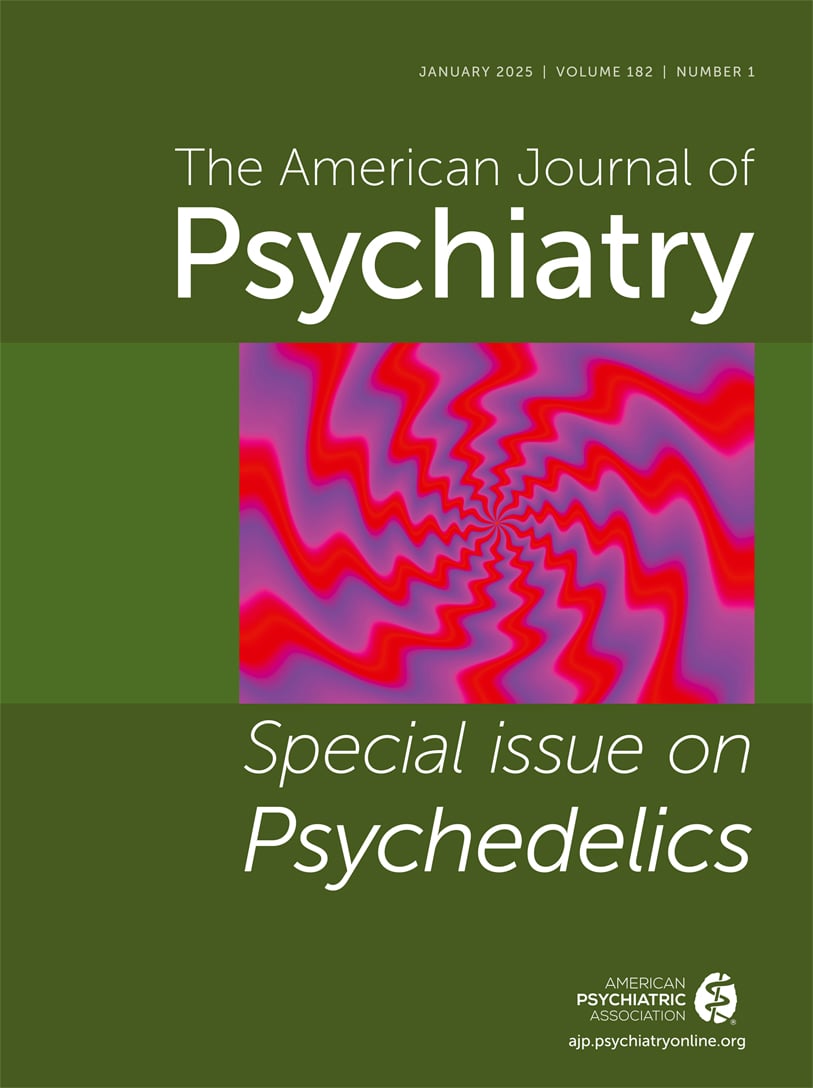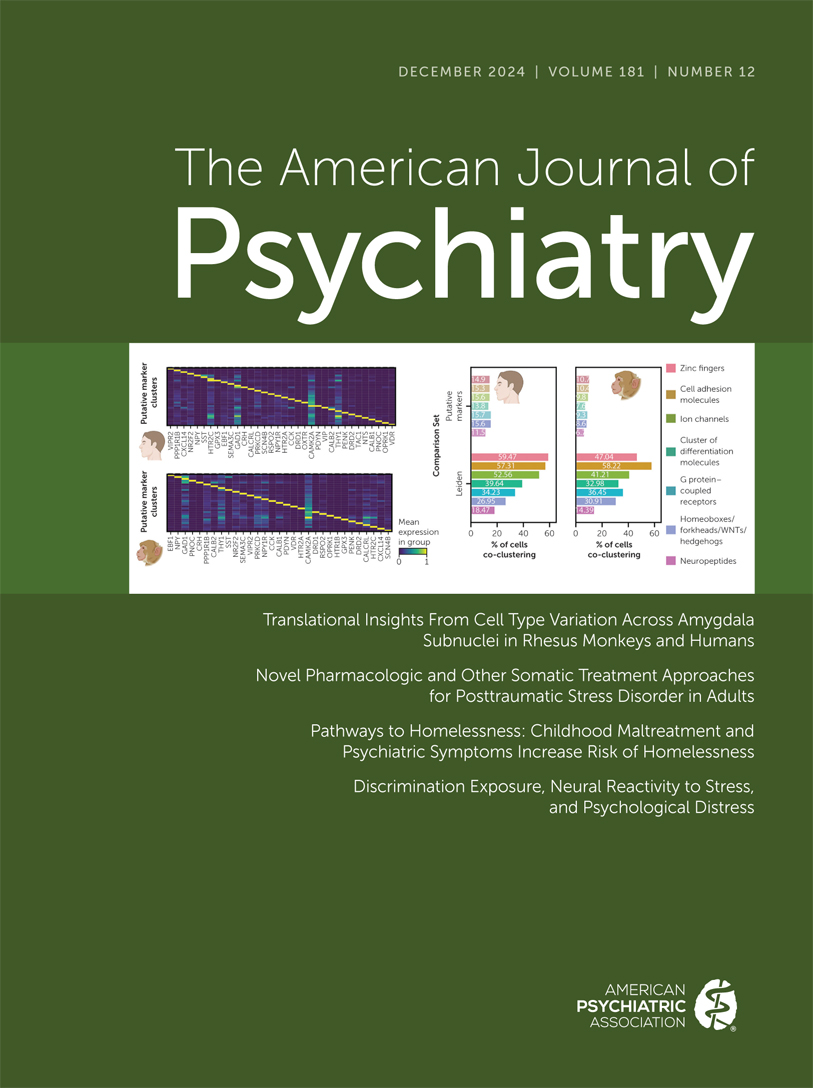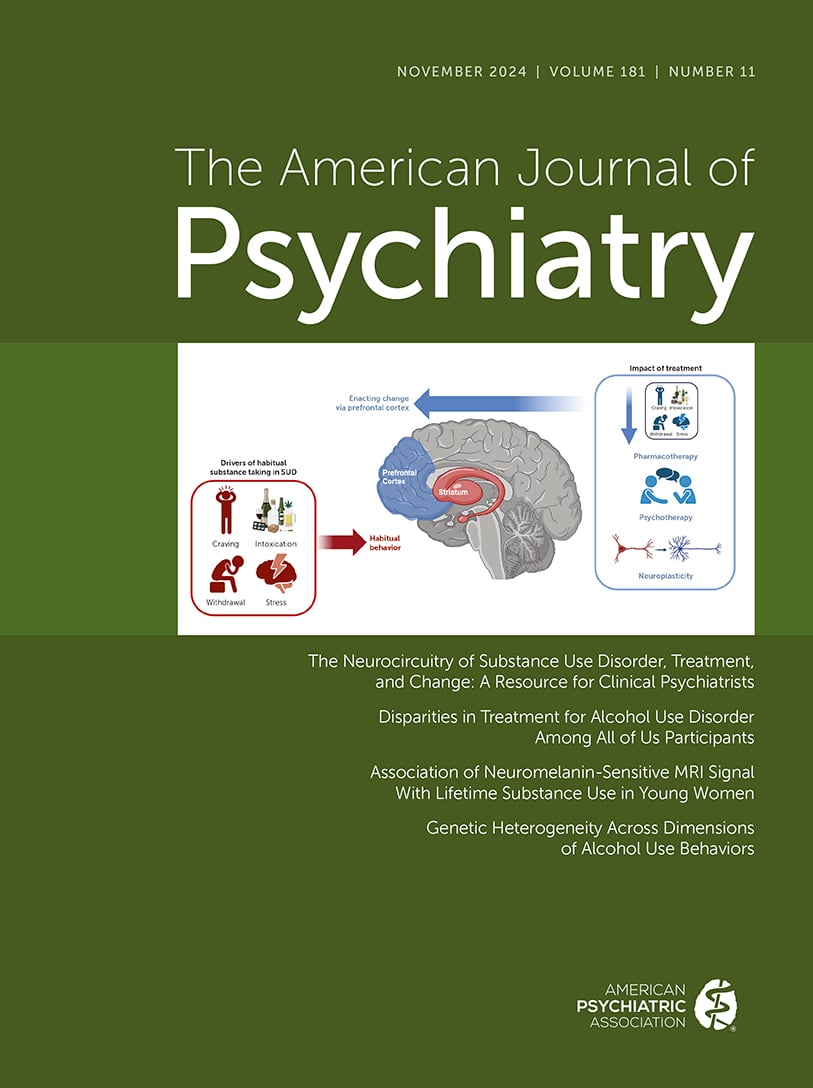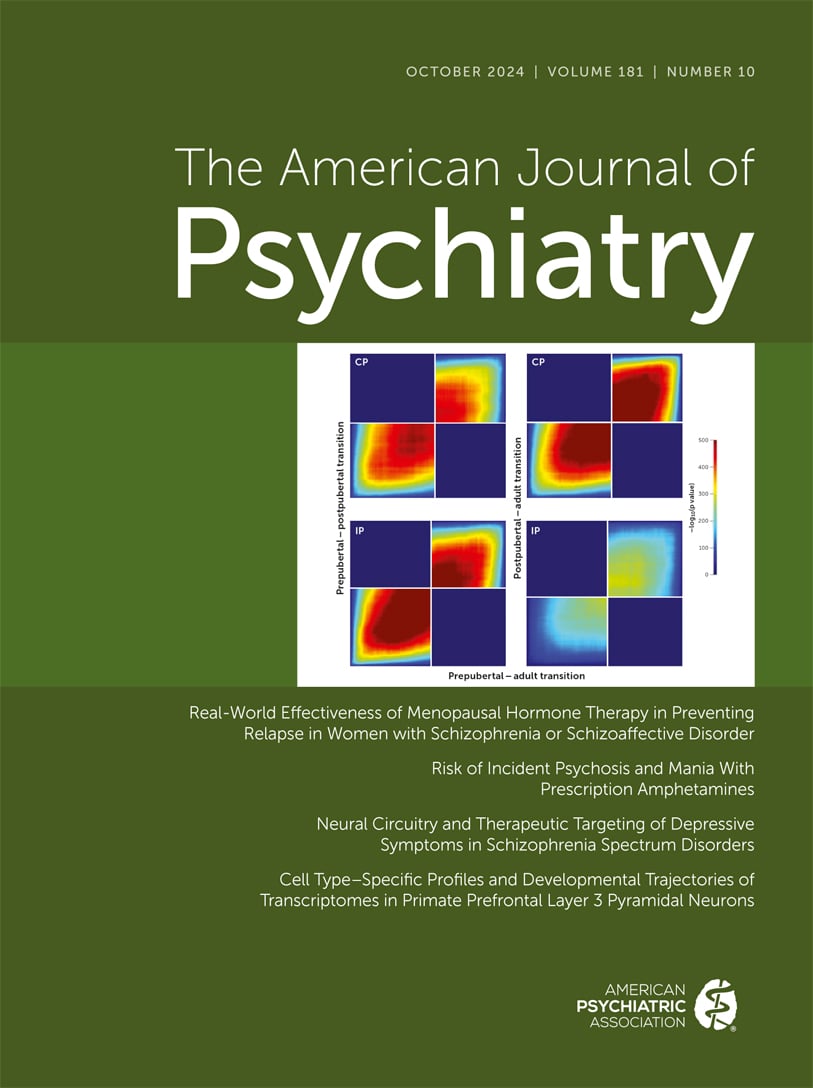American Journal of Psychiatry
- Volume 162
- Number 8
- August 2005
In This Issue
Editorial
Reviews and Overviews
Publication date: 01 August 2005
Pages1403–1413OBJECTIVE: A primary behavioral pathology in drug addiction is the overpowering motivational strength and decreased ability to control the desire to obtain drugs. In this review the authors explore how advances in neurobiology are approaching an ...
https://doi.org/10.1176/appi.ajp.162.8.1403Publication date: 01 August 2005
Pages1414–1422If neurobiology is ultimately to contribute to the development of successful treatments for drug addiction, researchers must discover the molecular mechanisms by which drug-seeking behaviors are consolidated into compulsive use, the mechanisms that ...
https://doi.org/10.1176/appi.ajp.162.8.1414Publication date: 01 August 2005
Pages1423–1431Psychiatrists have gradually developed a list of medications that are effective in the treatment of addictive disorders. Although alcoholism has received the most attention, nicotine, heroin, and cocaine have all been shown to be influenced by heredity. ...
https://doi.org/10.1176/appi.ajp.162.8.1423Publication date: 01 August 2005
Pages1432–1440In 1989, the National Institute on Drug Abuse (NIDA) established its Medications Development Program. This program has concentrated on developing pharmacotherapies for opiate and cocaine dependence and, more recently, for methamphetamine and cannabis ...
https://doi.org/10.1176/appi.ajp.162.8.1432Publication date: 01 August 2005
Pages1441–1451The authors review recent advances in the pharmacotherapy and pharmacogenetics of nicotine dependence. Despite the negative health consequences of smoking, approximately 23% of adults in the United States are daily tobacco smokers and approximately 13% ...
https://doi.org/10.1176/appi.ajp.162.8.1441Publication date: 01 August 2005
Pages1452–1460The past three decades have been marked by tremendous progress in behavioral therapies for drug abuse and dependence, as well as advances in the conceptualization of approaches to development of behavioral therapies. Cognitive behavior therapy, ...
https://doi.org/10.1176/appi.ajp.162.8.1452Publication date: 01 August 2005
Pages1461–1472OBJECTIVE: The authors examined the separate and combined effects of methamphetamine dependence and HIV infection on brain morphology. METHOD: Morphometric measures obtained from magnetic resonance imaging of methamphetamine-dependent and/or HIV-positive ...
https://doi.org/10.1176/appi.ajp.162.8.1461Publication date: 01 August 2005
Pages1473–1482OBJECTIVE: Animals self-administer many of the drugs that humans abuse, including cocaine. This article describes studies using preclinical animal models to differentiate the influences of neurobiological predisposition from environmental modulation of ...
https://doi.org/10.1176/appi.ajp.162.8.1473Publication date: 01 August 2005
Pages1483–1493The high rate of co-occurrence of substance use disorders and other psychiatric disorders is well established. The population of people with co-occurring disorders is heterogeneous, and the prevalence of comorbidity differs by diagnostic group. One of the ...
https://doi.org/10.1176/appi.ajp.162.8.1483Publication date: 01 August 2005
Pages1494–1502The past 30 years of research on the epidemiology of drug use, drug use disorders, and related conditions, such as HIV, has provided major insight into these conditions. Drug use peaked in the late 1970s, decreased across the 1980s, increased in the 1990s,...
https://doi.org/10.1176/appi.ajp.162.8.1494Images in Neuroscience
Introspections
Images in Psychiatry
Article
Publication date: 01 August 2005
Pages1507–1514OBJECTIVE: Research on the effects of cannabis on the brain and behavior has been surprisingly scarce. In humans, laboratory studies document toxicity and psychoactive effects of cannabinoids. However, among substance abuse patients, only a few studies ...
https://doi.org/10.1176/appi.ajp.162.8.1507Publication date: 01 August 2005
Pages1515–1520OBJECTIVE: In abstinent alcoholic patients, a low availability of dopamine D2/3 receptors in the ventral striatum and adjacent putamen was associated with a high level of craving for alcohol. Alcohol craving may also depend on presynaptic dysfunction of ...
https://doi.org/10.1176/appi.ajp.162.8.1515Publication date: 01 August 2005
Pages1521–1526OBJECTIVE: Screening of adults in primary care has been recommended to reduce alcohol misuse. This study determined the rates and predictors of alcohol screening, screening positive, follow-up evaluation, and subsequently diagnosed alcohol use disorder in ...
https://doi.org/10.1176/appi.ajp.162.8.1521Brief Report
Publication date: 01 August 2005
Pages1527–1529OBJECTIVE: Many schizophrenia patients remain undiagnosed and untreated for long periods of time. It has been suggested that untreated psychosis may have deleterious neurotoxic effects. However, studies examining the correlates of untreated initial ...
https://doi.org/10.1176/appi.ajp.162.8.1527Publication date: 01 August 2005
Pages1530–1533OBJECTIVE: The authors sought to expand previous findings of vermal abnormalities in bipolar disorder patients. METHOD: Magnetic resonance imaging (MRI) morphometry was used to quantify vermal subregion volumes in 18 subjects with first-episode bipolar ...
https://doi.org/10.1176/appi.ajp.162.8.1530Publication date: 01 August 2005
Pages1533–1535OBJECTIVE: Schizophrenia patients consistently demonstrate performance deficits on visual masking procedures. The present study examined whether attentional manipulation would improve subjects’ performance on visual masking. METHOD: A metacontrast task ...
https://doi.org/10.1176/appi.ajp.162.8.1533Six-Month, Blinded, Multicenter Continuation Study of Ziprasidone Versus Olanzapine in Schizophrenia
Publication date: 01 August 2005
Pages1535–1538OBJECTIVE: The authors’ goal was to compare the efficacy and tolerability of 6 months’ treatment with flexible-dose ziprasidone and olanzapine in patients with schizophrenia or schizoaffective disorder. METHOD: Brief Psychiatric Rating Scale (BPRS) scores ...
https://doi.org/10.1176/appi.ajp.162.8.1535Publication date: 01 August 2005
Pages1539–1541OBJECTIVE: Research suggests that the normal left-greater-than-right angular gyrus volume asymmetry is reversed in chronic schizophrenia. The authors examined whether angular gyrus volume and asymmetry were abnormal in patients with first-episode ...
https://doi.org/10.1176/appi.ajp.162.8.1539Letter to the Editor
Book Forum: Childhood Resilience
Book Forum: Geriatric Psychiatry
Book Forum: Substance Abuse
Book Forum: Personality and Personality Disorders
Correction
APA Official Actions
Past Issues
View Issues Archive
Vol. 182 | No. 1

Vol. 181 | No. 12

Vol. 181 | No. 11
